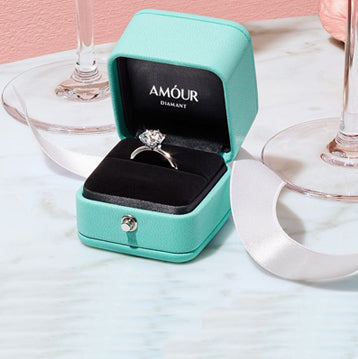What is the difference between Lab Diamonds and Moissanite?

When it comes to purchasing an engagement ring, one of the most important decisions is choosing the right gemstone. However, with so many options available, it can be difficult to know which type of gemstone is best for you. Two popular alternatives to traditional diamonds are lab-created diamonds and moissanite. Both of these options have their own unique characteristics and appeal, but what sets them apart from one another?
Lab diamonds
Lab-created diamonds, also known as lab diamonds or cultured diamonds, are diamonds that are grown in a laboratory setting using advanced technology. They are created using the same physical and chemical properties as natural diamonds, but are grown in a much shorter time frame. Lab-created diamonds are virtually identical to natural diamonds in terms of appearance, durability and physical properties. They are graded using the same standards as natural diamonds, and can be found in the same color, clarity and carat weight ranges. In other words the only difference is the origin. Once comes from the earth, another from a lab.

One of the main advantages of lab-created diamonds is that they are often less expensive than natural diamonds. Because they are grown in a laboratory, they do not have to go through the same costly mining process as natural diamonds. Additionally, lab-created diamonds are ethically-sourced and have a smaller environmental impact.
Another advantage of lab-created diamonds is that they are available in a wider variety of colors, including fancy colors such as blue and pink. They also offer more size options for larger carat weight diamonds, which can be rare and very expensive to find in natural diamonds.

However, lab-created diamonds also have some drawbacks. One disadvantage is that they are often not accepted as natural diamonds, and may not hold as much value in the resale market. Additionally, some people may prefer the unique characteristics of a natural diamond, such as its history.
The question is whether you want to save a significant amount of money by purchasing a lab-created diamond or if you prefer a natural gemstone at any cost. In terms of physical and chemical composition, there are no significant differences between the two.
Pros of lab-created diamonds:
- Less expensive than natural diamonds
- Ethically-sourced and have a smaller environmental impact
- Available in a wider variety of colors, including fancy colors such as blue and pink
- More size options for larger carat weight diamonds
- Virtually identical to natural diamonds in terms of appearance, durability and physical properties.
Moissanite
Moissanite, on the other hand, is a naturally occurring mineral that was first discovered in a meteorite. While it shares many of the same physical and chemical properties as diamonds, it is not a natural diamond. Moissanite is a relatively new alternative to traditional diamonds that has become increasingly popular in recent years.
One of the main advantages of moissanite is that it is significantly less expensive than diamonds. Moissanite is a fraction of the cost of a diamond, making it a great option for those on a budget. Additionally, moissanite is also very durable compared to diamond, scoring a 9.25 out of 10 on the Mohs scale of mineral hardness. This means that moissanite is also very resistant to scratches and chipping.
Another advantage of moissanite is that it is eco-friendly and ethically-sourced. Unlike natural diamonds, moissanite is not mined and it has a smaller environmental impact.

Moissanite also has some drawbacks, one of them being that it has a different optical properties than diamond, it has a higher refractive index and dispersion, which makes it sparkle more, but it may appear differently in certain lighting conditions. Additionally, some people may prefer the traditional look and feel of a diamond.
Pros of Moissanite:
- Significantly less expensive than diamonds
- More durable than diamond, with a higher resistance to scratches and chipping
- Eco-friendly and ethically-sourced, not mined
- Offers a unique and different appearance than a diamond
- Great for those on a budget and looking for durability and shine.
In conclusion, both lab-created diamonds and moissanite are great alternatives to natural diamonds. Both options have their own unique characteristics and appeal, and choosing between them ultimately comes down to personal preference and what is important to you. Lab-created diamonds offer an ethically-sourced, less expensive option that is virtually identical to natural diamonds, while moissanite is an eco-friendly gemstone that shines impressively and offers a budget-friendly option with a durability comparable to that of a diamond. It is important to consider your own preferences, budget and the purpose of the ring before making a decision.
Summary
- Origin: Lab diamonds are created in a laboratory using advanced technology, while Moissanite is a naturally occurring mineral that is extremely rare.
- Composition: Lab diamonds are made of carbon and have the same chemical composition as natural diamonds, while Moissanite is made of silicon carbide.
- Durability: Both Lab diamonds and Moissanite are durable and have high resistance to scratches and chipping.
- Appearance: Both Lab diamonds and Moissanite have a similar appearance to natural diamonds, but Moissanite has a different refractive index and can have a slightly different sparkle.
- Price: Lab diamonds are generally cheaper than natural diamonds, while Moissanite is cheaper than lab diamonds.
- Certification: Lab diamonds are often accompanied by certificates that certify their origin, while Moissanite is not certified.
- Ethical considerations: Lab diamonds are an ethical and sustainable alternative to natural diamonds and Moissanite is also a sustainable option and not associated with any ethical concerns.



































